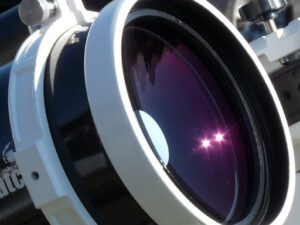Wondering about common types of telescopes for a hobbyist home observatory? There are roughly three options to consider in this field, with slight variations. We start with the most simple guide to available models’ pros, cons, and prices.
A telescope is a great acquisition for any space enthusiast. No matter if you are looking to buy one yourself or want a gift to surprise someone close to you. Today, there are so many optics types to choose from that shopping for the right one may seem a bit confusing. With a closer look at the available types of telescopes, it becomes clear that many definitions (Newtonian, Cassegrain, etc.) are often used interchangeably. In simpler words, all available telescopes for home use are optical devices that can be categorized into reflector, refractors, and compound ones. So, which telescope is best? That would depend on what you’re hoping to use it for. So, let’s get started with our quick guide to types of telescopes and their uses.
Refractor Telescope Type
The refractor telescope is the first type ever invented, so when asked, ‘What are the most common types of telescopes?’ people generally imagine this device. This is basically a large sense that captures light and sends it over a cylinder. Actual lenses used in this telescope type may be either achromatic or apochromatic. Achromatic lenses are usually cheaper, but they may generate chromatic aberration, aka false colour, that interferes with one’s stargazing experience. Apochromatic lenses solve this problem — for the human eye, at least, not for taking pictures that remain distorted regales of the tense type.
Refractor Types Of Telescopes Pros and Cons
Pros:
- Easy to maintain — as most basic telescopes for beginners, maintenance is no trouble at all;
- Durable — these are sturdy, reliable models that are not easily broken
- Easy to use — here, the eyepiece is located below the lens, which means you can gaze at the stars while relaxing in a chair or invite a child to astronomy lessons.
Cons:
- Chromatic aberration — colour distortion is inevitable
- High cost — the larger the lens and viewing distance, the higher the price gets
- Weight — these are bulky models that only get bulkier with more powerful lenses
Reflector Telescope Type
When looking for a more advanced telescope for space observation that solves the problem of chromatic aberration, consider the reflecting type. Instead of lenses, they use mirrors, and there are many subtypes to choose from. Even though these telescope types have problems of their own, Orbital Today and other trusted space resources report that this type is still widely used in astronomy observations. More importantly, it is more suitable for experienced hobbyist astronomers. If you are wondering, ‘Which type of telescope is more expensive?’, that would be a rather basic refractor model that simply uses more material than a compact reflecting type.
Reflector Telescope Type Pros & Cons
Pros:
- Advanced aperture — ensure observation at larger distances without colour aberration
- More affordable —generally cheaper than refracting models that rely on heavy lenses
- Small & lightweight — take less space at home and are way more portable than bulky refactors
Cons:
- Maintenance required — will have to be cleaned and recoated, often with professionals’ help
- Collimation — requires mirror re-alignment from time to time, which also calls for experience
- Distortion — may give up shape distortions instead of colour aberration

Compound Telescope Type
As their name suggests, compound telescopes use some features of both refractor and reflector optics. They are often called Maksutov-Cassegrain or Schmidt–Cassegrain, depending on scientists who improved on this type. Still, the basic logic is simple — the compound type uses lenses and mirrors in slightly different designs. As a result, this type solves most distortion problems, but obviously, it comes with a higher price tag. So, as far as compound type goes, what are the features of a telescope?
Compound Telescope Types Pros & Cons
Pros:
- Compact size — these telescopes are both small and lightweight, which means you will not only be able to use them at home — also while travelling and camping. This seriously improves your stargazing experience and gives you a chance to go beyond your home observatory limits.
- Most advanced optics — compared to other models suitable for home and amateur use, compound optics give the most advanced pictures with few errors, aberrations, or distortions.
Cons:
- High cost — all good things are pricey, and this telescope type can get more costly than even the bulkiest refractors. The upside is that your view will be way better than with refracting models
- Regular maintenance & collimation required — mirrors, sadly, will have to be painted and re-aligned regularly, so they are not very suitable for beginners.
With this in mind, amateur astronomers will have quite a few options to choose from, and there is no common type of telescope that works for everyone. In fact, there has never been a time in which there were so many telescopes available to the open public. It doesn’t matter if you are only daydreaming about buying a telescope, or you are already making your first steps towards buying one, we hope that this quick guide has made some basic telescope facts clear for you.
